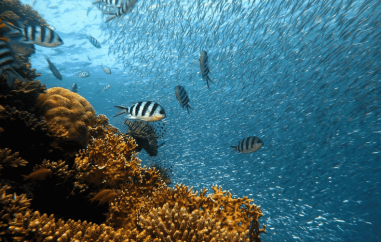From a great flood came unique underwater life
By Andrew Porterfield
When studying evolution, scientists don't often get the opportunity to see exactly how a modern species developed from a primordial ancestor--they pretty much rely on fossil evidence of predecessor species, and modern descendants. But small, super-salty basins at the bottom of the sea are showing scientists how one single species branched out into many new species, all adapting to these extreme environmental conditions.
When the Mediterranean Sea dried up 5 million years ago, it left a number of very salt basins, filled with microscopic plankton. Then, when the sea filled up again with seawater, these basins were left isolated from the rest of the world. Since the basin's brine is so much denser than ocean water, a very effective barrier was set up, allowing the basins to exist, virtually untouched, for millions of years.
Thorsten Stoeck, a biologist at the University of Kaiserslautern, Germany, found that plankton living in these sub-Mediterranean basins had evolved in very different ways, mostly because they adapted to the chemical compositions of their new home basins. Most of chemical challenges faced by these plankton were the same; high salt levels and little to no oxygen content. The study indicates not only how evolution can take different paths to create new species, but also suggests that many other new species may exist at the bottom of other salt-water basins, including the Red Sea and the Gulf of Mexico. The study appears in the July 8 BMC Microbiology.
Using next-generation sequencing techniques that allowed the identification of genetic markers that differentiated one type of plankton from another, Stoeck and his team were able to determine the different forms of ciliated plankton, one of the most-studied plankton and a model for evolutionary studies. All of the different forms of ciliated plankton (so called for their wavy appendages, known as cilia) descended from the same, identical stock.
The researchers found that at the border areas between four of the small basins (a few meters wide, in some cases), some mixing of ciliate plankton communities occurred, and these communities appeared very similar. But, when they looked at what were technically the same descendants living at the bottom of the brine basins (and out of touch with other communities), these plankton were very different from one another, even though they were adapting to the same chemical conditions. Therefore, the isolated plankton were able to take divergent evolutionary paths to adjust, illustrating how diverse species can become, even under the same circumstances.
"Each of our four communities had taken a subtly different route in adapting to anoxia and hypersalinity, resulting in four very different communities," Stoeck said. "Other ancient isolated habitats also occur in the Red Sea and Gulf of Mexico, and may also contain yet unstudied and potentially highly divergent ecosystems."















































